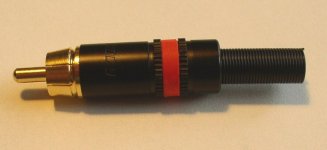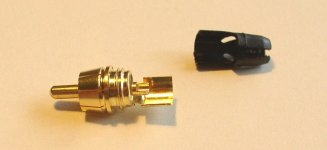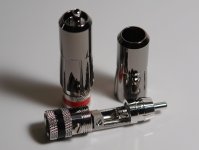Ideas for diy interconnects that deserves to build for our favorite audio system.
One of the materials that we can use is the enameled copper wire

Usually in sufficiently high quality copper (5N) in a variety of diameters, its an excellent conductor of acoustic frequencies,
its insulated and do not require other dielectric material. All it takes then is to cut the length of desired wire,
make sure the ends are clean and attach rca connectors of your choice
You can use neutrick rsa connectors known to the most of us.


There are other connectors which have clamps and can implement the enameled wire without soldering

You can start with a geometry of two parallel conductors.
Two pieces of the measure wire with a diameter of 0,6 mm, one for the signal and one for the ground for each channel .
The outcome certainly differ depending on your system but there are many goods at this recipe like
musicality , high transparency , great stereo image and great extent at the ends.
And all this with a few Euro.
You can Play around with different diameters as well as larger diameter favors low frequencies
and lower diameter favors high frequencies .
One of the materials that we can use is the enameled copper wire

Usually in sufficiently high quality copper (5N) in a variety of diameters, its an excellent conductor of acoustic frequencies,
its insulated and do not require other dielectric material. All it takes then is to cut the length of desired wire,
make sure the ends are clean and attach rca connectors of your choice
You can use neutrick rsa connectors known to the most of us.


There are other connectors which have clamps and can implement the enameled wire without soldering

You can start with a geometry of two parallel conductors.
Two pieces of the measure wire with a diameter of 0,6 mm, one for the signal and one for the ground for each channel .
The outcome certainly differ depending on your system but there are many goods at this recipe like
musicality , high transparency , great stereo image and great extent at the ends.
And all this with a few Euro.
You can Play around with different diameters as well as larger diameter favors low frequencies
and lower diameter favors high frequencies .
Last edited:
You can Play around with different diameters as well as larger diameter favors low frequencies
and lower diameter favors high frequencies .
?
For everything you need to know about selecting cable is quickly covered in these two BlueJeans Cable papers:
Subwoofer Cables from Blue Jeans Cable
LC-1 Audio Cable Design Notes -- Blue Jeans Cable
Other experts (Henry W. Ott, Bill Whitlock, Bruno Putzeys) write the same thing but use more words.
Even more quickly:
1] Low end to end resistance of the return (shield) wire.
2] Good shielding.
3] Low capacitance (for longer cables).
Subwoofer Cables from Blue Jeans Cable
LC-1 Audio Cable Design Notes -- Blue Jeans Cable
Other experts (Henry W. Ott, Bill Whitlock, Bruno Putzeys) write the same thing but use more words.
Even more quickly:
1] Low end to end resistance of the return (shield) wire.
2] Good shielding.
3] Low capacitance (for longer cables).
Last edited:
By skipping my first to items, the noise and/or interference can be much, much more audible. But then I have read that some audiophiles enjoy a little bit of noise or interference as it seems to add to the sound detail.
i would recommend you to twist the copper wire.
also, the tightness of the twist depends on your taste.
there's also good cheap cable to try.it's belden cat5e.i've been used them and they sounds good imo 🙂
also, the tightness of the twist depends on your taste.
there's also good cheap cable to try.it's belden cat5e.i've been used them and they sounds good imo 🙂
What advantages would a silver cable give you over a copper cable...not counting a minute decrease in resistance.
I tried interconnects in the past with the same type copper twisted , they were horrid you would have to have very bad interconnects for it to be an improvement ..


It baffles me why people want to make their own cables. It is simply impossible for a DIYer to make a better cable than a factory, but surprisingly easy to make a significantly inferior cable. Poor shielding, poor balance etc. invite in hum and RF interference. Some people even carefully choose materials to maximise cable microphony!
I would find it hard to think of a worse cable for audio interconnects than a hand-twisted pair of enamelled copper. Maybe an untwisted pair?
I would find it hard to think of a worse cable for audio interconnects than a hand-twisted pair of enamelled copper. Maybe an untwisted pair?
It baffles me why people want to make their own cables.
Because it's easier than an amplifier or speakers, and far less likely to cause smoke.
Someone has to feed us🙂
As Sy has said its the one area where all you need to do is be able to solder a wire to a connector (and not even that in some cases) to become the next Audiophile Guru, with the new best discovery for sound improvement. Though I do believe you do have to have a non-audiophile wife in the kitchen for verification (in my case I tend to do the cooking so I have a bit of a problem.
As Sy has said its the one area where all you need to do is be able to solder a wire to a connector (and not even that in some cases) to become the next Audiophile Guru, with the new best discovery for sound improvement. Though I do believe you do have to have a non-audiophile wife in the kitchen for verification (in my case I tend to do the cooking so I have a bit of a problem.
Doesn't our wives have better understanding of 'curtains' and 'veils' ???
At least they are the fist to notice, when they are removed, for one reason or another.....🙄
At least they are the fist to notice, when they are removed, for one reason or another.....🙄
There seems to be an untapped market here. I can think of at least two gizmos which would sell well:
1. something which would inject hum and RF into a normal interconnect, so that it sounds like a DIY or high-end interconnect.
2. something which would process the sound from a DAC or other digital source so it sounds like cassette: adding modulation noise, wow and flutter, gain pumping, and a randomly variable HF rolloff.
There is already a thread about adding ticks and pops so that digital sounds like LP! Have I fallen down into Alice's world again?
1. something which would inject hum and RF into a normal interconnect, so that it sounds like a DIY or high-end interconnect.
2. something which would process the sound from a DAC or other digital source so it sounds like cassette: adding modulation noise, wow and flutter, gain pumping, and a randomly variable HF rolloff.
There is already a thread about adding ticks and pops so that digital sounds like LP! Have I fallen down into Alice's world again?
cynicism!!!
For the cassette sound, maybe an 8 bit DAC with spread spectrum clock.
For the interconnects, they seem to be already doing a good job of that, but a good start would be enamelled copper wire, untwisted.
For the cassette sound, maybe an 8 bit DAC with spread spectrum clock.
For the interconnects, they seem to be already doing a good job of that, but a good start would be enamelled copper wire, untwisted.
There seems to be an untapped market here. I can think of at least two gizmos which would sell well:
1. something which would inject hum and RF into a normal interconnect, so that it sounds like a DIY or high-end interconnect.
2. something which would process the sound from a DAC or other digital source so it sounds like cassette: adding modulation noise, wow and flutter, gain pumping, and a randomly variable HF rolloff.
There is already a thread about adding ticks and pops so that digital sounds like LP! Have I fallen down into Alice's world again?
Already exists since the April '02 as a plug-in for ProTools, it is called Bomb Factory Funklogic Masterizer. It makes everything you run through sound worse by adding hiss, static, the sound of crackly pots etc.
It was available either as a free download directly from Funklogic or for $1695 from Avid/Digidesign.
- Status
- Not open for further replies.
- Home
- Design & Build
- Construction Tips
- hi fidelity diy interconnects
